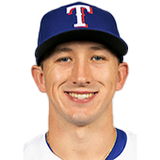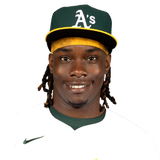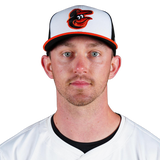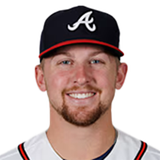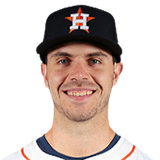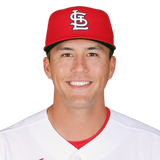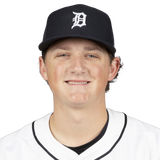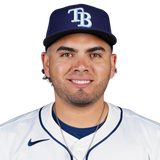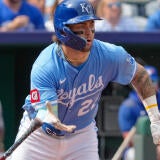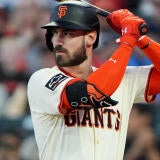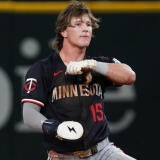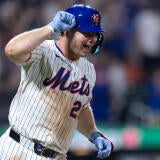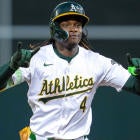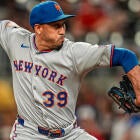| ||||||||||||
2025 Fantasy Baseball Draft Prep: Breakouts 1.0 for Scott White, featuring Lawrence Butler and Jonathan Aranda
These 12 are poised to perform better than ever before

Breakouts, huh? What exactly am I describing here?
If you want to think of this as an extension of my Sleepers 1.0, you'll get no arguments from me. Granted, they're not exactly the same. Not every breakout is a sleeper, which is primarily defined by its value. Not every sleeper is a breakout, which is primarily defined by its untapped potential. Still, the crossover between the two is considerable, with the central theme being that ... well, I like them.
- Sleepers 1.0: Scott | Chris | Frank
- Breakouts 1.0: Scott | Chris | Frank
- Busts 1.0: Scott | Chris | Frank
You'll notice a steep drop-off in ADP about halfway through this list, and that's when the sleeper crossover is most pronounced, by which I mean that the main appeal of the bottom six players is their value. The first six, on the other hand, aren't necessarily going any earlier than I'd draft them, but they have a good chance of performing better than ever before, thus meeting the definition of breakout.
Confused yet? Me too. Bored yet? Most definitely. Time to start naming names, then.
Wyatt Langford, OF, Rangers
NFBC ADP: 50.5
Judging by the ADP, you probably don't need much convincing to buy into Langford again after he let us all down in 2024, failing to live up to the massive numbers he put together in the minors a year earlier (batting .360 with 10 homers and a 1.157 OPS) and the equally massive numbers he put together the following spring (batting .365 with six homers and a 1.137 OPS). But if you're one of the stubborn holdouts who doesn't understand why we're falling for it again -- and at an even higher cost this time -- allow me to explain.
Langford hit .300 with eight homers, seven steals and a .996 OPS last September. Simple as. We had been waiting to see it all season long, and he finally delivered in the final month to end his rookie campaign on the highest possible note. He crammed basically half a season's production into that 30-day span, and in retrospect, it stands to reason that he'd need so much time. Hitting prospects in general have been taking longer to adjust to the majors the past few years (go back and look at Jackson Chourio's first two months ... or Gunnar Henderson's ... or Bobby Witt's ... or Julio Rodriguez's), and Langford was attempting to do it after just 44 minor-league games.
So early on, he struggled with the movement and velocity of major-league pitches, but all throughout, he maintained respectable strikeout and walk rates. He eventually adopted a more upright stance to make his swing more adaptable, and that's about when he took off. The specifics of his breakthrough are less significant to me, though, than the pattern. When things finally click for these elite bats, they don't look back, and I suspect the same will hold true for Langford.
James Wood, OF, Nationals
| ||||||||||||
NFBC ADP: 51.3
You know how I said that elite hitting prospects have by and large struggled to transition to the majors the past few years? That wasn't so much the case for Wood, who delivered enough power and speed in his three months on the job to average nearly as many Head-to-Head points per game for the season (2.82) as Jackson Chourio did (2.86). It wasn't a stellar performance, but it was a solid one, which these days is about all we can hope for when a hitter is first called up.
What makes the performance especially impressive, though, is that his flaws were plain to see. The growing pains that so many young hitters experience were also evident for Wood, but he's so tooled-up that he succeeded in spite of them. He struggled to put the ball in the air and to pull it, with rates that would place in the bottom 10 among qualifiers, and yet he still hit nine home runs in half a season's time, including seven to the opposite field. These rates can improve with better timing and pitch recognition -- the same sort of adjustments that Wyatt Langford needed five months to make -- and yet Wood was still a viable starter for Fantasy with them at their rock bottom.
How? He's incredibly strong, leveraging his 6-foot-7 frame for a 92.8 mph average exit velocity that would have placed in the top 15 among qualifiers, up there with Gunnar Henderson and Bobby Witt. Hitting the ball that hard is one way to overcome the near-30 percent strikeout rate that's almost a natural consequence of being 6-feet-7, but if Wood's minor-league history is any indication, he may be able to reduce that rate itself. He went from striking out 34 percent of the time at Double-A one year to 18 percent of the time at Triple-A the next, and the result was a .353/.463/.595 slash line. There's simply no overstating the ceiling here once everything clicks, and in the meantime, he'll still be must-start.
Lawrence Butler, OF, Athletics
| ||||||||||||
NFBC ADP: 73.6
Now that I've gotten the obligatories out of the way, let's discuss one who's dear to me personally. Butler doesn't come with a sparkling prospect pedigree and, thus, doesn't get the same presumption of sustainability when he does something right. But he always showed the capacity to hit the ball hard, such that if he could ever learn to make enough contact, things could go very right.
Turns out we underestimated just how right. Toward the end of June, immediately after Butler had returned from a month-long stint in the minors, Athletics director of hitting Darren Bush suggested that the 24-year-old make some mechanical tweaks aimed at eliminating excess movement and staying back on the ball. The results were immediate, and they were astounding. From July 1 on, or roughly half the season, Butler hit .302 with 20 homers, 14 steals and a .943 OPS. He cut his strikeout rate to 20.6 percent as compared to 30.7 percent in the 52 games prior, when he hit .179. He had two three-homer games during the surge and was basically on a 40-homer, 30-steal pace. Again, that's over half a season.
To me, that's long enough to call it legitimate, particularly since there was a dramatic improvement in strikeout rate to confirm the underlying changes. It's possible that after a long offseason, Butler could slip back into old habits and bring back the noisy swing that made him an easy out. (I'm not saying there's zero risk, which is why I'd be reluctant to take him inside of Pick 75, even as his ADP continues to climb.) But now that the Athletics know what works for him, I suspect any such hiccups to be short-lived. If he picks up where he left off, Butler might even be in the first-round discussion next year.
Bailey Ober, SP, Twins
| ||||||||||||
NFBC ADP: 86.3
People hate when I do this, but they're wrong. They're not appreciating the fine line between excellence and disaster in baseball and the degree to which sheer randomness comes into play. So here it is: You know the 3.98 ERA that Ober posted last year? How different would you feel about him if it was 3.18? All you have to do to get him there is remove two starts from the ledger:
- His season debut March 31 in which he allowed eight earned runs in 1 1/3 innings
- A second massacre Aug. 26 in which he allowed nine earned runs in two innings
"Yeah, but they happened," you'll say with a sneer. Sure, but they didn't have to. They weren't predestined, and they were clearly out of character. If you've watched baseball for any length of time, you'll know it doesn't take much to cause things to spiral. Anything from an unfortunately placed ground ball to a missed strike call or two could have triggered an avalanche big enough to bury the 6-foot-9 Ober. Who knows? Maybe he just had a headache that day and wasn't as sharp because of it. The season debut in particular was probably loaded with baggage. We don't know exactly where the blame lies because he hasn't volunteered it, but one thing we can't blame is a lack of talent, not with what the other 29 starts show.
You'll notice that Ober's ERA is the only real blemish in his stat line. His K/9 rate was solid, the 14th-best among qualifiers, and his 14.2 percent swinging-strike rate points to the potential for even more. His WHIP was excellent, the fifth-best among qualifiers, and between his elite control and high fly-ball rate (resulting in easy outs on contact), that's unlikely to change. Ah, but don't all the fly balls leave him vulnerable to home runs and (gasp) ERA inflation? Yes, but not to the extent we just saw. His xERA was only 3.22.
To give you an idea what Ober's 2025 could look like, look to Shota Imanaga. He has roughly the same profile -- excellent walk rate, pretty good strikeout rate, high fly-ball rate -- and actually had the higher xERA at 3.39, but his actual ERA was just 2.91, a full run lower than Ober's. You may think it's a reflection of talent, but the data tells us it was pure happenstance. Maybe they'll both be as good as that this year, but if their ERAs flipped, it wouldn't surprise me.
Jordan Westburg, 2B/3B, Orioles
| ||||||||||||
NFBC ADP: 94.4
To a certain degree, Westburg broke out last year, delivering an xBA and xSLG in the 92nd percentile with an average exit velocity (91.1 mph) on par with Kyle Tucker and Bryce Harper. If you project his actual totals over 150 games, they come out to 25 homers and 88 RBI, both of which would have ranked second among second base-eligible players. Yet I can think of a couple reasons why his Fantasy standing could improve further.
The first is that nobody's drafting him like that. Because he missed nearly two months with a fractured hand late in the year, he didn't actually play in those 150 games and achieve those numbers. But it's less a matter of people overlooking him, I think, than overlooking how he stacks up at second base. By and large, drafters aren't accounting for the position's scarcity, and he represents just one example.
The second reason is that I genuinely believe he could be even better this year. I said he was in the 92nd percentile for both xBA and xSLG, but I didn't give the actual numbers, which were .281 and .491, respectively. What it means is that Statcast thinks he should have had a higher batting average and slugging percentage than Harper, to name one, but he obviously didn't. And a big reason why is because of how punishing Camden Yards is for right-handed hitters. The decision to move back the entire left field fence 30 feet in 2022 completely devastated home run totals to that side, as I explained for Ryan Mountcastle in Sleepers 1.0.
But as I also explained for Mountcastle in Sleepers 1.0, that left field fence is moving back in this year, by 13 feet in some places and 26 in others, which should mean the park plays much fairer for right-handed power. In such an environment, 30 homers are well within the range of outcomes for a hitter who impacts the ball as Westburg does, and second basemen who can reach that threshold are exceedingly rare. Let's also not rule out the possibility of Westburg attempting to steal more bases, a likely scenario given his 91st-percentile sprint speed.
Spencer Schwellenbach, SP, Braves
| ||||||||||||
NFBC ADP: 98.4
The forward-facing numbers from his rookie season are impressive enough that we don't need to see further improvement to justify drafting Schwellenbach among the top 30 starting pitchers. What we really need is confirmation. You see, he didn't arrive with a sparkling pedigree or to great fanfare, and in a year that favored pitching, it's possible that a lesser talent could "fake" numbers of such quality over a partial-season sample. (Anyone remember Vance Worley? One such example.) So for Schwellenbach, "breaking out" would simply mean sustaining what he's already done.
And I'm willing to bet it'll happen. For as impressive as the forward-facing numbers were, the underlying ones were downright stellar. His control is already elite, as evidenced by a walk rate would have ranked fifth among qualifiers, up there with Logan Gilbert and Tarik Skubal. He was also one of just four pitchers (minimum 100 innings) to throw at least 69 percent of his pitches for strikes. While he averaged just over a strikeout per inning, his 13.5 percent swinging-strike rate points to even more strikeout upside, and he achieved it not just with one wipeout pitch but a deep six-pitch arsenal that he was willing to mix up from game to game. His polish certainly stands out for someone with his inexperience, but it verges on prodigious when you consider that last year was only his second as a full-time pitcher. He was a two-way player in college.
So yeah, Schwellenbach is good, and if he shows it over a full season, he'll probably be in the ace conversation for 2026.
Spencer Arrighetti, SP, Astros
| ||||||||||||
NFBC ADP: 218.6
You notice the drop-off in ADP here? Yeah, I could more appropriately call Arrighetti a sleeper than a breakout. Perhaps the most succinct way of putting it is that people are sleeping on a breakout that already happened. I'm referring to the two-month stretch at the end of last season in which Arrighetti put together a 2.72 ERA, 1.17 WHIP and 11.4 K/9. It was obviously a great departure from the rest of his season, which had been pretty terrible up to that point, and we can't completely rule out the possibility it was a blip. But while a lower ERA is achievable over a two-month span purely by happenstance, an elite strikeout rate is harder to fake. Arrighetti had three double digit-strikeout efforts in those 10 appearances. Add another from back on June 20, and he actually had more for the year than Tarik Skubal.
But what actually changed to turn his season around? For one thing, he stopped throwing his fastball so much, dropping its usage to below 40 percent. An overreliance on the fastball is a common problem for pitchers breaking into the big leagues, which isn't so bad when it's the highlight of their arsenal, but that's absolutely not the case for Arrighetti. His yielded a .303 batting average and .528 slugging percentage. By comparison, his curveball and sweeper were untouchable, yielding batting averages of .171 and .113, respectively, and they were also the main source of his whiffs.
As he began to find more success, he also became more comfortable going on the attack, issuing 3.1 BB/9 over the final two months compared to 4.6 BB/9 over the first four. Whether he can sustain those gains is less certain to me given that he also struggled with walks throughout his minor-league career, but it's worth noting that his actual strike percentage wasn't bad. In fact, it was right in line with league average at 64.4 percent, suggesting that his walk issues are less a matter of ability than confidence -- confidence that, again, I think he now has.
Tyler Fitzgerald, SS, Giants
| ||||||||||||
NFBC ADP: 235.9
Calling Fitzgerald a breakout is asking for trouble because he's almost certain to fall short of his 2024 pace. I say "pace" and not "numbers" because the numbers he delivered came in just two-thirds of a season. Give him, say, 150 games, and he ends up with a .280-25-57-89-29 line that looks a lot like Jose Altuve or even Trea Turner. (Maybe a .280 batting average would be on the lower end for them, but you get the idea. Fitzgerald's pace was excellent.)
So let's think about this for a second. Knowing that and only that, should we be drafting him outside of the top 225, behind the likes of Zack Gelof, Maikel Garcia and Connor Wong? Surely not, and that's basically the breakout case for him. His stellar 2024 showing didn't earn him an ounce of respect, but I'm guessing he'll get that respect this season as new GM Buster Posey's choice to play second base -- a position that could use another capable bat, by the way.
Anything else I could say about Fitzgerald would undermine what to me is an open-and-shut case, but in the interest of full disclosure ... I get the skepticism. With a strikeout rate over 30 percent, he's not hitting .280 again. His xBA was only .227. With an average exit velocity in the 22nd percentile, he shouldn't be capable of a 25-homer pace. His xSLG was only .378. The speed is legit, but if the hitting collapses, it won't matter. And by the data, the hitting should collapse.
But Fitzgerald was more or less the same guy at Double- and Triple-A and also mashed there (in some not-so-hitter-friendly ballparks, it turns out), slashing .292/.365/.511 in 2023 and .310/.402/.718 in 2024. It may be that, like Isaac Paredes, his swing is so perfectly optimized for home runs that the exit velocities are ancillary. His elevated fly-ball and pull rates would suggest so.
Clearly, Fitzgerald isn't living up to last year's pace, but a more realistic one would see him hit .235 with 20 homers and 30 steals. That's like a best-case scenario for Anthony Volpe, and he's going 100 picks earlier.
Lars Nootbaar, OF, Cardinals
| ||||||||||||
NFBC ADP: 262.9
We've been down the breakout trail with Nootbaar before, and at this point, fatigue is beginning to set in. (Probably should have packed something more substantial, eh?) But the facts on the ground haven't changed. He's still a fantastically disciplined hitter (98th percentile walk rate) who impacts the ball exceptionally well (88th percentile average exit velocity), yielding expected stats that exceed his actual ones. If you look at his Baseball Savant page, you're still blinded by all the red.
I think more than anything, what's prevented him from meeting his potential the past couple years is health. Three times he went on the IL in 2023 and twice in 2024, missing the first couple weeks of the season with a fractured rib and more than a month midseason with a strained oblique. Sure, all the ground balls didn't help. His 51.7 percent rate was his highest yet and would have ranked fifth among qualifiers, according to FanGraphs. But after spending last offseason working with Nolan Arenado to address exactly that, it seems to me that broken rib derailed Nootbaar's progress right out of the gate and perhaps instilled some bad habits as he struggled to catch up. But don't take my word for it ...
"I felt like I was in a good place heading into spring and then the ribs happened," Nootbaar said in late September. "I think I forgot some of the things that I was working on because I couldn't do those movements. I tried to play catch-up a little bit, but it was my fault for not being a great self-evaluator. I needed to not forget certain things we worked on in the offseason."
Those comments came at the end of a month in which got his ground-ball rate down to 44.4 percent and went on to slash .290/.421/.565, hitting four of his 12 home runs on the year. More of that, and he's another Brandon Nimmo.
Reese Olson, SP, Tigers
| ||||||||||||
NFBC ADP: 276.0
Olson had a 1.92 ERA through 10 starts last year but also a 1-5 record. He would then lose his next three starts, taking him to 1-8, and make only six more before being shut down for two months with a shoulder strain. So you'd be forgiven for never warming up to him in Fantasy. The simple truth is that he wasn't so impactful.
But that doesn't mean he didn't pitch well. He's already learned what Spencer Arrighetti needed four months to figure out, which is that his fastball is a change-of-pace offering and not the pitch to lead with. He's taken the idea further, in fact, throwing his fastball in about equal measure to his slider and changeup, two quality pitches with better than a 40 percent whiff rate. Most pitchers would be pleased to have one pitch with such a whiff rate. Olson has two, which helps make up for the unremarkable fastball.
All Olson would need to do to break out, really, is pick up where he left off and stay healthy this time. Better win-loss luck is a given even before you account for the fact that the Tigers suddenly transformed into a contender during the time he was sidelined by the shoulder issue, and just adding a healthy win total would make him another Nathan Eovaldi type for Fantasy. But there's hope for even more, I think. If Olson can leverage those two high-whiff secondary offerings into more than a strikeout per inning and become a master at home run prevention with his better-than-50-percent ground-ball rate at a pitcher-friendly home venue, numbers closer to Justin Steele may be in store.
Matt Shaw, 3B, Cubs
| ||||||||||||
NFBC ADP: 333.1
The case here is pretty straightforward. Shaw is a top prospect (third in my top 100, it turns out) with a wide-open path to a starting job. And it's not some happy accident either. The Cubs included Isaac Paredes in the Kyle Tucker trade precisely to clear a path for Shaw. So where's the enthusiasm? Why isn't he getting the same reaction that Wyatt Langford and Jackson Chourio got last year? Granted, the overall ADP includes drafts from before the Tucker trade, when Shaw wasn't in line for the job yet, but even since Dec. 14, the day after the trade, Shaw's ADP is only 218.5. He's kind of an also-ran.
But he's also the complete package for Fantasy, projecting for batting average, power and speed. The raw tools may not be loud, in part because he stands only 5-feet-9, but they're optimized to all get-out. He excels against all pitch types, drives the ball to both his pull side and the opposite field, and is appropriately aggressive on the base paths. Though his overall numbers are excellent, he really hit his stride over his final 80 games, batting .318 with 18 homers, 21 steals and a .959 OPS (just double it to find out the 162-game pace). He slips out of the top 25 in some prospect rankings because his defense is suspect, but as long as it's good enough for the Cubs to play him, as they seemingly intend to do, it's a moot point for Fantasy.
The truth is that I wouldn't want to target Shaw on the level we did Langford and Chourio last year. I'm keenly aware that hitting prospects have needed longer to adjust to the majors in recent years, so drafting him as my starter at third base is a bigger gamble than I'd like to take. I'm also aware that as the buzz begins to build in spring training, his stock is likely to climb. Still, if I'm looking for upside outside of the top 175 players or so, he's a prime target for me.
Jonathan Aranda, 1B, Rays
| ||||||||||||
NFBC ADP: 424.3
Sorry for the fakeout, everyone. Turns out 2025 is Aranda's year. Sure, I thought it would be 2024, and to be fair, he had seemingly wrapped up the starting DH job with a strong spring showing. But that's about the time he broke his right ring finger, and that's about the time all his troubles began.
A broken right ring finger sounds about as insignificant as broken bones get, particularly for a left-handed hitter, but it required surgery and kept Aranda out long enough that he seemed totally off-kilter when he returned. Gone were the impeccable bat-to-ball skills that had defined his career to that point, replaced by a 34.5 percent strikeout rate over a 44-game span between the majors and minors. Something had clearly gone wrong with his process, and it would take a two-month IL stint for a strained oblique to set him right again. He homered four times in his first six games back from that injury, earning a quick promotion to the majors, and in all, he hit .289 with nine homers and a .958 OPS in 32 games after returning. Best of all, his strikeout rate was back down to 17.6 percent.
That's more in line with his potential, and I think just scratching the surface of it. Remember, this is the guy who hit .339 with 25 homers and a 1.063 OPS in 95 games at Triple-A Durham two years ago with a walk rate (14.7 percent) that would have ranked third among all major-league hitters and exit velocity readings (92.2 mph average and 113.0 mph max) that compared favorably to Marcell Ozuna and Corey Seager. It's a hitting profile that's almost too good to believe, and while it's possible Aranda's left-handedness and defensive limitations cost him at-bats here and there, he's expected to get an extended look in the DH role again, this time without all the health interruptions. Don't lose faith in the breakout just because he's 26.


